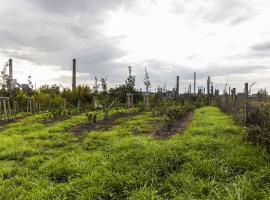The CLAIRO Project Journal N°2

Executive summary
While the previous period of CLAIRO was dedicated to laying down the basic framework for project delivery, the second one was marked by a significant progress in activities, with first key results starting to appear. This second edition of CLAIRO Journal captures project implementation progress during the past period, from March 2020 to December 2020.
Core activities in this period were linked to the design of the greenery, measurements of pollutant concentrations, development of a model for quantifying air pollutant capture with the designed greenery, and the organization of a second round of a public opinion survey.
The detailed design of the greenery structure and composition to be established in Radvanice and Bartovice has been finalized in summer 2020. The objective is to establish communities of trees and shrubs in the two target sites of CLAIRO that form continuous and dense canopies that allow effective filtration of the air.
Communities of multiple plant species with similar ecological needs were specified that correspond to the habitat conditions of the target sites. The intention was to create a multi-level tree cover so as to maximise the capture of air pollutants.
By Autumn 2020 the team of Palacky University has refined the details of the method aimed to increase the tolerance of plants to abiotic stress, adapting it to the specific conditions at the target sites and the objectives of CLAIRO.
Measurements of air pollutant concentrations and climatic conditions that had started in September 2019, continued throughout 2020 and are to be performed also in 2021 and the upcoming years in Ostrava. The aim is to provide essential data for the development of a model of pollutant capture. A modular sensor network is used in CLAIRO that allows real-time simultaneous measurement of gas pollutants and particulate matter in the air. The evaluation of air pollution situation, the meteorological parameters and natural conditions and the capture of pollutants by the existing greenery, allowed the development of a model of the designed new greenery.
Besides Ostrava measurements are also undertaken in other neighbouring cities in the Ostrava- Karvina Industrial Agglomeration to obtain background data, and to support additional green infrastructure interventions across the region. The monitoring activity outside Ostrava first was undertaken in Trinec and Opava between January and August 2020. In a second round, measurements are currently carried out in Frydek-Mistek and Karvina.
The second model that enables the quantification of air pollutant capture with the designed greenery was developed by Autumn 2020. With the help of the model, it can be tracked how the total leaf area, and with this PM10, ozone and nitrogen dioxide capture are changing at the target sites of CLAIRO when the current vegetation is replaced with the proposed one.
In Ostrava and nearby towns two public opinion surveys were conducted under CLAIRO on air quality in 2019 and 2020. The results showed that almost 60% of the people living in the Ostrava agglomeration take an active interest in air quality and also consider topic to be very important. The surveys revealed that people living in towns nearby Ostrava support the objectives of CLAIRO.
By providing details of the main activities and achievements linked to key project component, the second journal explores how the challenges identified are addressed, and outlines how changing circumstances as a result of the COVID-19 pandemic are handled by the partnership.
Key activities and interim results
Executive summary
While the previous period of CLAIRO was dedicated to laying down the basic framework for project delivery, the second one was marked by a significant progress in activities, with first key results starting to appear. This second edition of CLAIRO Journal captures project implementation progress during the past period, from March 2020 to December 2020.
Core activities in this period were linked to the design of the greenery, measurements of pollutant concentrations, development of a model for quantifying air pollutant capture with the designed greenery, and the organization of a second round of a public opinion survey.
The detailed design of the greenery structure and composition to be established in Radvanice and Bartovice has been finalized in summer 2020. The objective is to establish communities of trees and shrubs in the two target sites of CLAIRO that form continuous and dense canopies that allow effective filtration of the air.
Communities of multiple plant species with similar ecological needs were specified that correspond to the habitat conditions of the target sites. The intention was to create a multi-level tree cover so as to maximise the capture of air pollutants.
By Autumn 2020 the team of Palacky University has refined the details of the method aimed to increase the tolerance of plants to abiotic stress, adapting it to the specific conditions at the target sites and the objectives of CLAIRO.
Measurements of air pollutant concentrations and climatic conditions that had started in September 2019, continued throughout 2020 and are to be performed also in 2021 and the upcoming years in Ostrava. The aim is to provide essential data for the development of a model of pollutant capture. A modular sensor network is used in CLAIRO that allows real-time simultaneous measurement of gas pollutants and particulate matter in the air. The evaluation of air pollution situation, the meteorological parameters and natural conditions and the capture of pollutants by the existing greenery, allowed the development of a model of the designed new greenery.
Besides Ostrava measurements are also undertaken in other neighbouring cities in the Ostrava- Karvina Industrial Agglomeration to obtain background data, and to support additional green infrastructure interventions across the region. The monitoring activity outside Ostrava first was undertaken in Trinec and Opava between January and August 2020. In a second round, measurements are currently carried out in Frydek-Mistek and Karvina.
The second model that enables the quantification of air pollutant capture with the designed greenery was developed by Autumn 2020. With the help of the model, it can be tracked how the total leaf area, and with this PM10, ozone and nitrogen dioxide capture are changing at the target sites of CLAIRO when the current vegetation is replaced with the proposed one.
In Ostrava and nearby towns two public opinion surveys were conducted under CLAIRO on air quality in 2019 and 2020. The results showed that almost 60% of the people living in the Ostrava agglomeration take an active interest in air quality and also consider topic to be very important. The surveys revealed that people living in towns nearby Ostrava support the objectives of CLAIRO.
By providing details of the main activities and achievements linked to key project component, the second journal explores how the challenges identified are addressed, and outlines how changing circumstances as a result of the COVID-19 pandemic are handled by the partnership.
Key activities and interim results
Challenges for implementation
Implementing a project that applies and disseminates a comprehensive methodology maximizing the positive impact of urban greenery on air quality, exploits innovative solutions will lead to a number of challenges that have to dealt with. Various risks and challenges that are faced by Ostrava during the implementation of the project are outlined below.
Lessons learnt and conclusion
It is no surprise that the new coronavirus crisis has affected significantly the way CLAIRO was managed in the past 9-10 months. Despite all the hurdles brought by the pandemic, the project team could ensure that the delivery of key outputs that had been foreseen for this period were not affected by the changed working environment. The detailed design of the greenery structure and composition, and the model of pollutant capture with designed greenery were finalized, air quality measurements continued, and the second public opinion survey was conducted as originally planned. On the positive side, the pandemic has highlighted the need for urban air quality and the importance of preserving and further developing urban green infrastructure. Nevertheless, outreach to key external stakeholder groups might be adversely impacted by lockdowns. The planning of public events will need to be revisited, that can imply changes to their structure, format and frequency, so that they can have the same impact even under changed circumstances that do not favour socializing.
The fact that a series of models are built on each other under CLAIRO, makes the application of an effective iterative learning process possible, enabling continuous improvements. The hypothetical model of pollutant capture by designed greenery will be tested by continuous measurements of pollutant concentration levels after planting. The application of this loop learning process will enable the refinement of the general model. Still the appropriate use of the mass of data collected during the lifetime of the project that allow the development of a sound and user-friendly composite model will require the intensive cooperation of separate working teams.
Although the complexity of CLAIRO, that is addressing at the same time air quality, green space governance, and targeted stakeholder management, can make the harmonization of key project components difficult, it can also bring some benefits. Complexity can create a stronger narrative for the project that can be effective in mobilizing and bringing together representatives of relevant areas of expertise and help justify additional green infrastructure interventions.
In the upcoming months the partnership will undertake core activities, translating theory into tangible outputs. The planting of greenery will be undertaken in the target areas of the project between March and May 2021. The planting will be followed by innovative soil and plant treatment in the two target sites. A model of pollutant capture by planted greenery will be developed by summer 2021. A more concise manual targeting decision-makers and urban practitioners, and a detailed methodology intended for the academic and professional community will be elaborated introducing the CLAIRO methodology. The next edition will explore the results of these key activities.
References
Barwise, Y., Kumar, P. (2020) Designing vegetation barriers for urban air pollution abatement: a practical review for appropriate plant species selection. npj. Climate and Atmospheric Science. IF 5.365. DOI: 10.1038/s41612-020-0115-3.
Chen, L., Liu, C., Zhang, L., Zou, R. & Zhang, Z. (2017) Variation in tree species ability to capture and retain airborne fine particulate matter (PM2.5). Sci. Rep. 7, 3206.
Grote, R. et al. (2016) Functional traits of urban trees: air pollution mitigation potential. Front. Ecol. Environ. 14, 543–550.
Janhäll, S., (2015) Review on urban vegetation and particle air pollution. Deposition and dispersion. Atmos. Environ.
Lawson, T. & Blatt, M. R. (2014) Stomatal size, speed, and responsiveness impact on photosynthesis and water use efficiency. Plant Physiol. 164, 1556–1570.
Raupach, M.R. et al. (2001) The entrapment of particles by windbreaks. Atmos Environ. 35:3373–3383.
Vos, P. et al. (2013) Improving local air quality in cities: To tree or not to tree?, Environmental Pollution, Volume 183, 2013, p 113-122, ISSN 0269-7491.
Watanabe, Y. (2015) Canopy, leaf surface structure and tree phenology: Arboreal factors influencing aerosol deposition in forests. Journal of Agricultural Meteorology 71(3):167-173. DOI: 10.2480/agrmet.D-14-00011.
Weerakkody, U., Dover, J. W., Mitchell, P. & Reiling, K. (2018) Evaluating the impact of individual leaf traits on atmospheric particulate matter accumulation using natural and synthetic leaves. Urban For. Urban Green. 30, 98–107.
Wei, X. et al. (2017) Phylloremediation of Air Pollutants: Exploiting the Potential of Plant Leaves and Leaf-Associated Microbes. Front. Plant Sci., 28 July 2017.


































